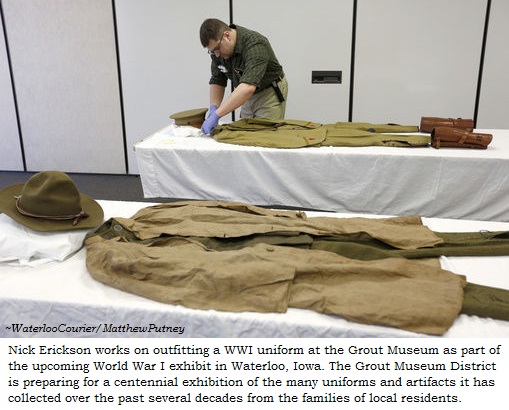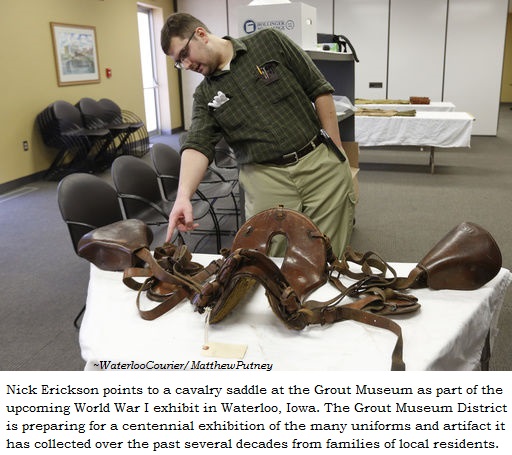


Cerro Gordo County, Iowa
Part of the IAGenWeb Project
|
The Waterloo-Cedar Falls Courier Waterloo, Black Hawk County, Iowa Sunday, February 26, 2017
by Pat Kinney

WATERLOO, Iowa (AP) — It was called "the war to end all wars." But it wasn't. The United States entered it to make the world "safe for democracy," only to have to fight totalitarianism again a quarter century later. It was called the Great War, the World War, but finally became known as World War I. For America, it started 100 years ago this year, and the Grout Museum District is preparing for a centennial exhibition of the many uniforms and artifacts it has collected over the past several decades from families of local residents, the Waterloo-Cedar Falls Courier reported. While there are no living veterans of that war, the Grout amassed a considerable collection from families of those veterans and will have much of it on display for six months, beginning in June, in an exhibit titled "From the Prairie to the Trenches: Iowans in the Great War." Museum staff is already preparing items for exhibition. "The advantage of World War I is that we have such a large collection," said Chris Shackelford, the Grout district's exhibits and programs assistant. Some is in archives and a smaller amount is on permanent display in the Grout's Sullivan Brothers Iowa Veterans Museum. "For how much we already have in our permanent exhibit, it's going to be really nice to get out so much of what we have." Like World War II some 20-25 years later, America initially delayed entering the European conflict by two to three years, until April 1917. By the time the war ended 19 months later, in November 1918, four million Americans served, half of them overseas, and 116,000 lost their lives and another 200,000 were wounded. About 115,000 Iowans served and 3,000 were killed or wounded, according to the National Archives. Waterloo's Fairview Cemetery contains a circle of World War I soldiers' graves around a machine gun of that era. Some of the items at the Grout include uniforms of: Pvt. Leonard Walters of Tipton, who served in the U.S. Army Medical Corps as an orderly or ambulance driver; Lt. Col. C.C. Bronson of Waterloo, a member of Iowa Gov. William Harding's personal honor guard during the war. The uniform is rare in that the sleeves bear red stars — which soon became impossible to wear when they became the emblem of the Red Army following the birth of the Soviet Union in October 1917. A uniform of a U.S. Army Air Service mechanic, Private John H. Rohrssen of Barclay Township in Black Hawk County, who was stationed at Kelly Air Field in San Antonio, where he served on border patrol against the forces of Mexican revolutionary Pancho Villa, who raided Columbus, N.M., and locations in Texas in 1916. Haddys Hixson, a U.S. Marine who served in a supply unit, and the father of Dale Hixson, active for years with Becker-Chapman Americal Legion Post 138.

A complete horse cavalry saddle and stirrup set, various boots and munitions and a Marlin "potato digger" light machine gun will also be included. "And there's so many complete sets of personal belongings," said Nick Erickson, museum collections registrar at the Grout, who is writing and researching a University of Northern Iowa graduate paper on the war. "The peak donation time for World War I veterans was the 1970s and '80s, because that's when most of the First World War veterans were dying. We've seen a little uptick lately, as people clean out attics of the next generation," children of World War I veterans who kept their parents' artifacts. Some older individuals who kept their parents artifacts, aging themselves, are simply "looking for a rightful place" for those artifacts. "This is a privilege to be able to do this exhibit," Erickson said. "A part of this project is actually getting us organized and finding out what we have available to us for World War I," said Erin Dawson, the Grout's exhibits curator. "We're going through our collections, picking out what's World War I and then narrowing down, depending on what we see the exhibit becoming." In addition to marking the 100th anniversary of America's entry into the war, "we're trying to place special interest on minority populations and women's involvement in the war," Shackelford said. More than 200,000 African-Americans served in World War I. "There'll be a large section devoted to the training of African-Americans at Fort Des Moines, Camp Dodge," Shackelford said, "as well as some very particular stories, anecdotal stories about women's service, not only just in the armed services but the Red Cross and other service organizations affiliated with the military." "They served alongside, not quite in yet," Dawson said of women's service. But that service was important. Another portion of the exhibit will be the reactions to the war on the home front. Tentative start date for the exhibit is June 27, Dawson said. It will run concurrent with a year-long Korean War exhibit to begin in July. One historic figure connecting the two exhibits, and conflicts, is Gen. Douglas MacArthur, and Grout staff said that will be acknowledged. MacArthur, best known as commander of U.S. ground forces in the Pacific in World War II, was a commander in the Army's 42nd "Rainbow Division" during World War I which included Iowa units, and he also was United Nations forces commander in Korea until dismissed by President Harry Truman, a fellow World War I veteran. According to a Black Hawk County historic website maintained by the University of Northern Iowa, Rainbow Drive, a main road in Waterloo-Cedar Falls, was so named in 1918 to honor Earl King, one of Black Hawk County's first volunteers in World War I. He was a member of Company B Infantry, 42nd Rainbow Division.
Photographs courtesy of Globe Gazette
|